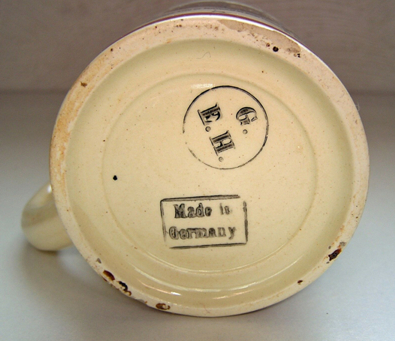
 Stein Collectors International
Stein Collectors International
Featured Stein: October 2019

 Stein Collectors International
Stein Collectors International
Featured Stein:
October 2019
Although technically not a stein (because it was never intended to have a lid), this mug is certainly a collectible piece of Americana, and it opens a window to a very curious time in American history.

The mug, a souvenir of Salem, MA, depicts three notable buildings in that city. From left to right around the body of the mug are "The Birthplace of Nathaniel Hawthorne," "The House of Seven Gables," and "The Old Witch House." In a separate reserve, a witch on a broomstick appears above the center image. While the building where Nathaniel Hawthorne was born and the House of Seven Gables are historical in their own right, the appearance of a building known as "The Old Witch House" coupled with the witch on a broomstick suggest there is more to be learned here.
Thought to be built between 1620 and 1640, the Witch House, home of Judge Jonathan Corwin, derives its name from his association with the Witchcraft Trials of 1692. While witch trials had begun to fade out across much of Europe by the mid-17th century, they continued on the fringes of Europe and in the American Colonies. The events in 1692/1693 in Salem became a brief outburst of a sort of hysteria in the New World, while the practice was already waning in most of Europe. As a local magistrate and civic leader, Corwin was called upon to investigate the claims of diabolical activity when a surge of witchcraft accusations arose in Salem and neighboring communities.
The Salem Witch Trials, conducted between February 1692 and May 1693, were a series of hearings and prosecutions of people accused of witchcraft. (Despite being generally known as the Salem Witch Trials, the preliminary hearings in 1692 were conducted in several towns: Salem Village, now Danvers; Salem Town; Ipswich; and Andover.) Salem Village was known for its fractious population and numerous internal disputes, and for disputes between the village and Salem Town (present-day Salem). Arguments about property lines, grazing rights, and church privileges were rife, and quarrels with neighbors often incited witchcraft allegations. One example of this is Abigail Faulkner, who was accused in 1692. Faulkner admitted she was "angry at what folk said," and the Devil may have temporarily overtaken her, causing harm to her neighbors. Women who did not conform to the norms of Puritan society were more likely to be the target of an accusation, especially those who were unmarried or did not have children.
The trials were started after people had been accused of witchcraft, primarily by teenage girls such as Elizabeth Hubbard, 17, as well as some who were younger. More than 200 people were accused, 19 of whom were found guilty and executed by hanging (14 women and 5 men). One other man, Giles Corey, was crushed to death for refusing to plead, and at least five people died in jail. It was the deadliest witch hunt in the history of colonial North America.
An overwhelming majority of people accused and convicted of witchcraft were women (about 78%). Overall, the Puritan belief and prevailing New England culture was that women were inherently sinful and more susceptible to damnation than men were. Throughout their daily lives, Puritans, especially Puritan women, actively attempted to thwart attempts by the Devil to overtake them and their souls. Indeed, Puritans held the belief that men and women were equal in the eyes of God, but not in the eyes of the Devil. Women's souls were seen as unprotected in their weak and vulnerable bodies.
The episode is one of Colonial America's most notorious cases of mass hysteria. It has been used in political rhetoric and popular literature as a vivid cautionary tale about the dangers of isolationism, religious extremism, false accusations, and lapses in due process. It was not unique, but a Colonial American example of the much broader phenomenon of witch trials in the early modern period, which also occurred in Europe.

Of course, stein
collectors
always want to know "Who made it, and how old is it?" I feel safe in
saying that it dates to the early 1900s, but I am not familiar with the
marks on the base.
Thanks to Master Steinologist Roy DeSelms for pointing out this mug for sale on eBay. The historical summary of the Witch Trials is based on information on Wikipedia.